
The insects of the beetle family Chrysomelidae are commonly known as leaf beetles, and include over 37,000 species in more than 2,500 genera, making up one of the largest and most commonly encountered of all beetle families. Numerous subfamilies are recognized, but the precise taxonomy and systematics are likely to change with ongoing research.
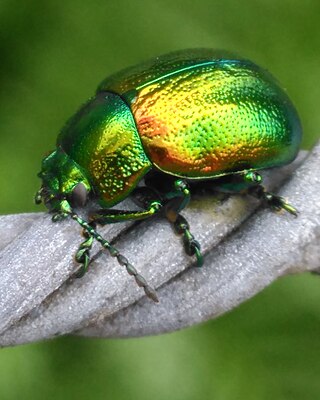
The tansy beetle is a species of leaf beetle. The common name derives from its main foodplant, Tansy, but it can also use other wetland plants such as Gypsywort and Water Mint. It measures 7.7–10.5 mm in length and has a characteristic bright metallic green colouration, with pitted elytra and a coppery tinge. In addition to the nominotypical subspecies, which repeats the specific name, C. graminis graminis, there are five further distinct subspecies of Tansy beetle, which, collectively, have a Palearctic distribution, although in the majority of countries where it is found the species is declining. In the United Kingdom it is designated as 'Nationally Rare'. The stronghold population here is located along the banks of the river Ouse in York, North Yorkshire. Other, small, fenland populations exist at Woodwalton Fen and at Welney Wildfowl and Wetlands Trust (WWT) reserve.

The cereal leaf beetle is a significant crop pest, described by Carl Linnaeus in 1758.
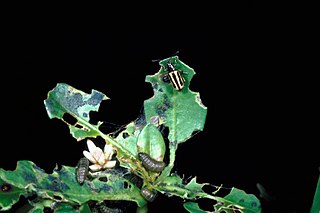
Agasicles hygrophila is a species of leaf beetle known by the common name alligator weed flea beetle. It has been used successfully as an agent of biological pest control against the noxious aquatic plant known as alligator weed.
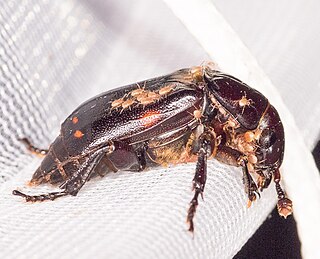
Nicrophorus pustulatus, also known as the pustulated carrion beetle or blistered burying beetle, is a species of burying beetle that was described by Johann Karl Wilhelm Illiger in 1808.
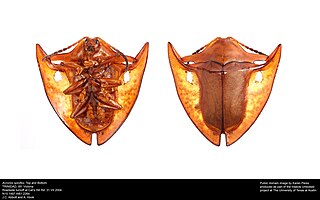
Acromis spinifex is a species of tortoise beetle from South America. The males have enlarged elytra which are probably used in male–male combat, while females are among the few tortoise beetles to show maternal care of their offspring.
Denaeaspis is an extinct genus of tortoise beetle in the family Chrysomelidae and containing a single species Denaeaspis chelonopsis. The species is known only from the Middle Eocene Parachute Member, part of the Green River Formation, in the Piceance Creek Basin, Garfield County, northwestern Colorado, USA.

Bromius obscurus, the western grape rootworm, is a species of beetle in the leaf beetle family. It is the only member of the genus Bromius. The distribution of the species is holarctic; it can be found in North America, wide parts of Europe, and Asia. The species is a known pest of grape vines in Europe and western North America.

Pyrrhalta is a genus of beetles in the leaf beetle family, Chrysomelidae. Species are distributed throughout much of the world, including much of the Northern Hemisphere and the Australian region.
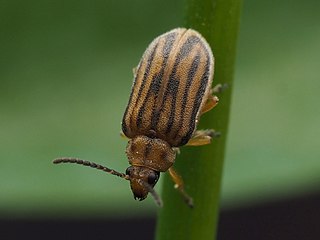
Ophraella communa, common name ragweed leaf beetle, is a species of beetles belonging to the family Chrysomelidae.
Psylliodes luridipennis, commonly known as the Lundy cabbage flea beetle or the bronze Lundy cabbage flea beetle, is a species of flea beetle endemic to the island of Lundy, where it lives and feeds upon the endemic Lundy cabbage. Along with the true weevil Ceutorhynchus contractus var. pallipes and an undescribed race of flea beetle Psylliodes napi, it is known only from the Lundy cabbage. The species was first recorded by Thomas Vernon Wollaston in the 1840s, and was named by the Austrian entomologist Franz Kutschera in 1864.

Geodorcus ithaginis, the Mokohinau stag beetle, is a large flightless species of stag beetle in the family Lucanidae. It was described by Thomas Broun in 1893 after being discovered in the Mokohinau Islands by Andreas Stewart Sandager, a lighthouse keeper on the islands. The species survives only on the small unnamed island "Stack H", in a patch of vegetation the size of a living room, and is in extreme danger of extinction.
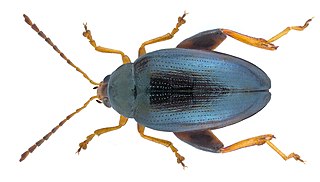
Psylliodes chrysocephala or Psylliodes chrysocephalus, commonly known as the cabbage-stem flea beetle, is a species of leaf beetle situated in the subfamily Galerucinae and the tribe Alticini.

Sphaeroderma testaceum, the artichoke beetle, is a species of flea beetles in the family Chrysomelidae.
Bledius annularis, or ringed borrow rove beetle, is a species of spiny-legged rove beetle in the family Staphylinidae. It is found in North America.
Acronymolpus is a genus of leaf beetles in the subfamily Eumolpinae. It is endemic to New Caledonia. There are two species placed in the genus, both of which are sexually dimorphic; the females are large and reddish, and the males are small and black. A member of the tribe Eumolpini, Acronymolpus is distinguished from other members of the tribe in New Caledonia by its enlarged metacoxae, which occupy most of the first abdominal ventrite and nearly reach its posterior margin.
Phyllotreta liebecki is a species of flea beetle in the family Chrysomelidae. It is found in North America.
Ophraella slobodkini is a species of skeletonizing leaf beetle in the family Chrysomelidae. It is endemic to the Southeastern United States. Adult males measure on average 4.35 mm (0.17 in) and adult females 4.96 mm (0.20 in) in total length. It is associated with Ambrosia artemisiifolia.
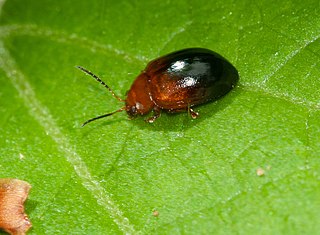
Nisotra is a genus of flea beetles in the family Chrysomelidae. They are found in Africa, Asia, and Australia. There are around 90 described species in Nisotra, including about 70 in Sub-Saharan Africa and Madagascar. Many of these species are agricultural pests.
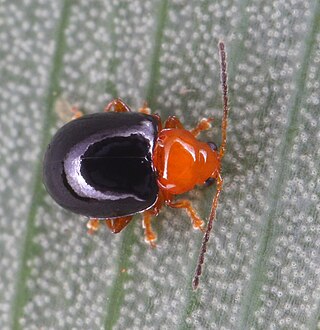
Stuckenbergiana is a genus of flea beetles belonging to the family Chrysomelidae. There is a single described species, Stuckenbergiana glabrata, which is found in South Africa.














